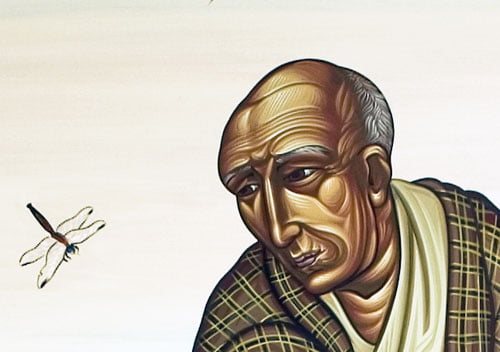Some have heard his name, some have not. But we have all seen or know about the Great Wave of Kanagawa, simply called “the Wave”. It is one of the most iconic internationally known pictures. It is arguably the most famous image in all of Japanese art. Katsushika Hokusai was a Japanese artist, an ukiyo-e painter and printmaker of the Edo period.
He was born in Edo, modern Tokyo in 1760. He led a life that was both productive and undeniably eccentric. So, who was he? Let’s find out more about this famous artist.
He was supposed to be a mirror polisher
As is the case with many great people, Hokusai was not instantly destined to be an artist. Instead, he was adopted by an uncle at a young age, who had a prestigious position of mirror polisher. At the time, it was widely assume that the young Hokusai will succeed his uncle in the family business. He received a great education for the position.
Because in Japan, learning to write also meant learning to draw, young Hokusai found love for drawing and painting. At just the age of 6, he displayed artistic talent that led him to a new path. He began to separate himself from his uncle’s business in his early teens. When he was 19 years old, he joined the studio of a ukiyo-e artist Katsukawa Shunsho, and this is where his career in art started.
He changed his name 30 times
Not only he changed his name 30 times, Hokusai also moved places more than 90 times. To be exact, 93 times. The reason behind this was simple, he hated cleaning and found it distasteful. He allowed dirt and grime to build up in his studio, and once it became unbearable, he moved out.
![]()
Changing your own name was customary among Japanese artists at the time, but Hokusai took the practice to a whole new level. Combine all of his pseudonyms, the used more than 30 names in total. His tombstone bears his final name, which is Gakyo Rojin Manji. The translation is “Old man mad about painting”.
He illustrated board games
Painting was not the only thing he did. He also illustrated board games, paper lanterns, cut-out dioramas, and instruction books. He was one of the leading designers of toy prints during the 19th century.
His illustrations for board games features a depicted a pilgrim’s route between Edo and nearby religious sites. His work for board games served as a precursor for his masterpiece, “Thirty-Six Views of Mount Fuji”.
In addition to illustration countless books of poetry, he also published his own how-to manuals for aspiring artists. Hokusai Manga, which was filled with drawings for students to copy, became a best-seller.
He made the Wave at the age of 70
A great example of “you are never too old”, Hokusai began his most famous work at the age of 70. He was prosperous in middle age, but a series of setbacks including death of his second wife and serious misconduct by his wayward grandson, left Hokusai in financial straits during his later years.
Because of that, he began working on his most famous series, which also included the Great Wave. He fuelled his energy into the Thirty Six Views of Mount Fuji, and also used introduction of Prussian blue to the market.
Because the Prussian blue was cheaper as a synthetic pigment, it was feasible enough to use the shade in prints for the first time. And Hokusai took full advantage of its potential.
Produced more than 30,000 works
Hokusai enjoyed an exceptionally long career. His career officially began in 1779, and lasted until his death in 1859 at the age of 89. In other words, he was able to work for almost 70 years. And during those years he intensely productive, rising with the sun and painting late into the night.
While many of his works were destroyed due to fire in his studio in 1839, he is thought to have produced some 30,000 paintings, woodblock prints, picture books, and sketches in total. According to some sources, his last words were a request for five or ten more years in which to paint.
He was the pioneer of Impressionist movement
While the Japanese government enforced isolationist polices during his life, his works still managed to influence Western art history. It is worth mentioning that these isolationist policies prevented foreigners from entering and citizens of Japan from leaving the country.
But when the country opened its borders in the 1850s, his work crossed continents and landed in the hands of artists like Claude Monet and Edgar Degas. The later was inspired by Hokusai for his sketches of the human form. Art history experts believe Hokusai was so influential in the Western world because of his Asian perspective, which positioned far-away objects higher on the picture plane. The affect made it appear as though the ground was tilting upwards to a Western eye.



